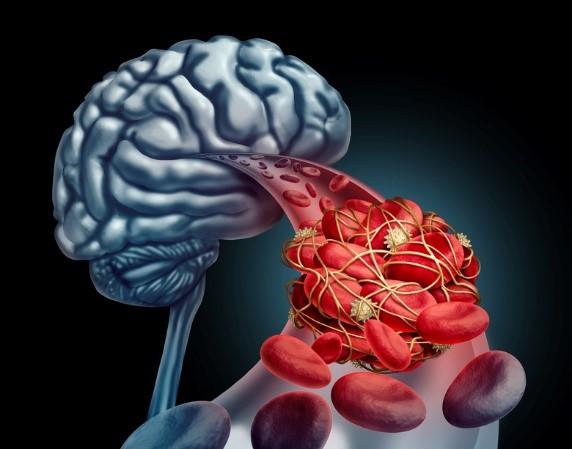Sadly, someone very special to me recently suffered a stroke and is now undergoing surgery…so I was inspired to raise awareness here.
Also known as cerebral vascular accident (CVA), a stroke is very scary because it’s not like your brain taps you on the shoulder and says, “Hey—I’m getting less blood up here and that ain’t good.”
Here is the scoop on this condition that is the number 5 cause of death in the US, as well as a leading cause of long-term disability…and how you can prevent your number from coming up.
The anatomy of a stroke
Simply put, a stroke is when the blood supply to your brain is interrupted, and there are 3 different ways this can happen:
1. Ischemic Stroke
With an ischemic stroke, the blood supply to your brain is reduced or cut off. This is the most common type of stroke, representing about 90 percent of cases.
There are three factors that can trigger an ischemic stroke:
- Thrombosis: A clot forms inside an artery in the brain or neck that dislodges and starts to move.
- Embolism: A clot moves from another area of the body to the brain, blocking a major artery.
- Stenosis: Narrowing of an artery leading to the brain that limits the circulation of blood.
2. Hemorrhagic Stroke
With this type of stroke, there is bleeding in the brain. When blood is spilling out of a vessel in the brain, your brain cells cannot get enough for their needs.
There are two types of hemorrhagic strokes:
- Intracerebral hemorrhage occurs when an artery in the brain bursts.
- Subarachnoid hemorrhage occurs when there is bleeding in the area between the brain and the tissues that cover it.
3. Transient Ischemic Attack (TIA, or “mini-stroke”)
A TIA is different from the 2 other (major) types of stroke because blood flow to the brain is blocked for only a short time—usually less than 5 minutes.
But a TIA is a warning sign of a future stroke, so it’s nothing to blow off.
How the damage is done
After just 4 minutes without an adequate supply of blood and oxygen, your brain cells become damaged and begin to die.
Your body tries to restore blood and oxygen to the brain by enlarging other arteries near the area. But if that doesn't happen quickly enough or the "emergency" blood supply is inadequate, permanent brain damage usually occurs.
When your brain cells become damaged or die, the body parts that are controlled by those cells lose their ability to function properly.
This can range from mild to severe and temporary to permanent. It depends on where and how much of your brain is damaged and how fast the blood supply is restored.
About half of all people who have a stroke will have long-term problems with talking, understanding, and decision-making. They also may have behavior changes that affect their relationships.
Other long-term complications of a stroke can include depression and pneumonia.
Prevention is where it’s at!
The good news here is that experts estimate that at least 80 percent of strokes can be PREVENTED.
Here are 4 important measures you can take to keep the odds in your favor:
1. Quit smoking
Smoking is the #1 most controllable risk factor for stroke and is directly responsible for a higher proportion of strokes in young adults.
And smokers of ALL ages have a double risk of ischemic stroke compared to nonsmokers.
2. Exercise regularly
Exercise helps ALL of your cells and organ systems to work properly and helps your body eliminate toxins--all of which can improve the health of your blood vessels and prevent blockages.
Plus exercise helps naturally lower blood pressure, which is another major risk factor for stroke.
Now, don’t roll your eyes here. You don’t have to join a gym or buy expensive equipment. Brisk walking is a great activity and just about anyone can do it.
There are also DVD programs you can use in your home.
That’s how I was inspired to start karate, by the way—by doing Billy Blanks’ Tae-Bo workouts in my living room! Now 15 years later I’m a 4th degree black-belt and master instructor.
3. Have a healthy diet of real foods
Having a healthy diet of real foods is the biggest bang for your buck in terms of stroke prevention:
- Your body is better able to get the nourishment that it needs for all your cells--including your precious brain cells.
- Wastes and toxins can be more efficiently eliminated, so they are less likely to gum up your blood and contribute to artery blockages.
- You can more easily maintain a healthy body weight. Obesity is a risk factor for stroke too.
Concentrate on fresh fruits and vegetables, meats, poultry, wild-caught fish, eggs and good fats (real butter, olive oil, coconut oil, avocado and nuts).
At the same time, avoid refined carbs and sugars. These stir up inflammation in your body, and inflammation is a leading contributing factor to high blood pressure and atherosclerosis.
Refined carbs also increase your risk of developing Type 2 diabetes, which is yet another stroke risk factor.
Also, stay far away from diet soda (and artificial sweeteners in general). Studies have shown that drinking diet soda nearly triples the risk of stroke and dementia!
If you need help transitioning to a healthier diet, let my Great Taste No Pain system guide you all the way!
You’ll learn all about the dangers of bad fats and carbs, why artificial sweeteners are poison, and much more!
Plus, you’ll learn how to pair foods together in your meals to pave the way for smooth, comfortable digestion, and less gas, bloating, heartburn and constipation.
And the dishes in the recipe section are the bomb!
4. Get enough Vitamin D
Recent studies have shown that low vitamin D levels are associated with higher risk for stroke, and worse outcomes in patients suffering from ischemic strokes.
Unfortunately, current estimates show that nearly 80 percent of us are running low in vitamin D!
But you can ensure that you have healthful levels of this crucial nutrient with Optimum DK Formula with FruiteX-B!
Optimum DK Formula provides a health-supporting 5,000 IUs of vitamin D3 in every daily dose, plus its partners vitamins K1 and K2, and the mineral boron.
These nutrients work synergistically to help support cardiovascular health, as well as bone and immune health too!
To your health,
Sherry Brescia











I agree with Ann’s comment. Those that have had stroke can not have Vitamin K. I’m still learning about the difference between vitamin K1 and K2. I don’t understand why K is being added to multivitamins and supplements knowing that there are many stroke or heart attack victims out there who have to stay away from K.
Hi Ann! Thank you for sharing your story and thoughts. We appreciate your insight and applaud your efforts to improve your health naturally!
I don’t know why my comment posted twice.
I probably had the small strokes in summer of 2015. I first noticed my balance was a little “off” when we were finishing up our bathroom remodel, and I was painting, on the ladder. I had no symptoms of anything that was “going wrong” to indicate I was having them. I went on the search for answers beginning in February of 2016, and finally got the consultation with the neurologist in June. After X-rays of my neck, and MRIs of my neck and brain, I was given the diagnosis, the “prescription” and a therapy location for brain re-training. Zero nutritional advice! He didn’t even order that blood test to find out what thickness my blood was! I finally had one in October, after meeting with my family NP. She has since retired, and I’ve been going it alone, reading everything I see that is health related.
I ended up with hearing problems, in addition to the balance issues. After going to several hearing specialists, they found nothing wrong! So, I’ve concluded the problem is the damage inside my brain.
My next big hope is to have stem cells infused!
This is a very interesting topic, and article. Thanks for explaining things concerning stroke!
However, being a victim of what the neurologist called “small strokes”, and being given a prescription to “take a baby aspirin every day”, I’ve been on my own journey to find out the best way to treat myself, and hopefully avoid further such strokes. In this process, I’ve discovered that perhaps I inflicted the damage on myself with the wrong foods… healthy foods! Lots of romaine salads, lots of cabbage and broccoli, lots of peas, mostly snow peas. And other things I now know that I shouldn’t be eating! How do I know? Body testing. If everyone could be taught how to do this, imagine how much better off everyone would be! Vitamin K is in all those foods, they are green… but of the two kinds of K you mentioned, I should eat only the K2, but should avoid the K1. So, if fruits and veggies came with the label of which type of K is in them, think of the suffering I could have a avoided! Each of us is different, and has separate dietary needs. Blanket advice is what I always thought was correct for me, but now I suffer from lack of proper knowledge. I would encourage every single person have the blood test that tells you how thick or thin Your blood is, and if it is off, use proper nutrition, and supplementation to set it right! I refused to poison my system with aspirin, and even tho supplements are more costly, they are safer.